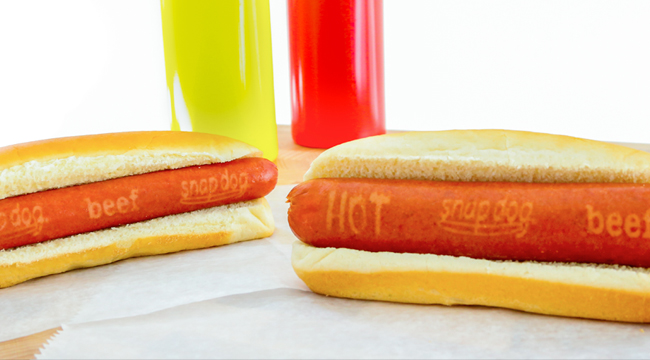
I usually know exactly what I’m getting myself into when I order a hot dog… that being: I have no idea what I’m getting myself into. I remember reading the ingredients on hot dog packaging like the super inquisitive, weird little 7-year-old I was and scruntching up my nose.
“Disgusting!” I thought. “I am literally eating random ground-up animal parts!”
In middle school, I read about the governmental health allowances for what can legally be processed into hot dogs and still safe to eat. It was not a great educational experience. Then, in 2009, the items found in hot dogs over the course of one calendar year were revealed by the USDA. It was grim.

If you can’t read that entry, I’ll give you a cheat sheet: Worms. Lots of worms.
It wasn’t until I was an adult that I learned the novelty of a 100% beef frank in a world full of fake meat. Even then, I had questions. I wanted to know what was up with my dogs like the Portlandia couple wanted to know about their chicken.
I wasn’t the only skeptic. We’re living in an era where food manufacturers are doing what they can to keep costs down and production up. At any given time, what we think we’re eating could turn out to be completely different from what we actually put in our mouths. As so many studies have proven of late, the problem of “fake food” is probably far bigger than you think,
Keith Dorman — a man with a family history of making cheat codes for food (his great grandfather is the guy responsible for the pieces of paper that keep cheese slices from sticking together) — was every bit as concerned as me. The food manufacturer believes people should have a right to know what’s in their food, and that labels ought to accurately reflect what’s in the package.
In fact, he’s trying to put the labels on the food itself: stamping his new brand of hot dogs with info about their ingredients.

Dorman’s journey to “food wokeness” started when he decided to expand a barbecue restaurant he owned and turn it into “fast, casual barbecue” in the way that Chipotle, Panera Bread, and Starbucks have turned usually slower-paced, sit-down experiences into quick, grabbable bites. He wanted to do it in a cost effective way, too. That meant not purchasing tons of real-estate.
“I looked at all these hot dog carts that are already out there on the streets,” Dorman says of his first eureka moment. “Instead of taking years to have 30 locations, it could literally happen overnight.”
The process wasn’t quite that quick, but growth did boom. Soon, Dorman had a fleet of hot dog stands.
“It didn’t happen overnight,” Dorman says, “but over about two months, I think we got up to about 30 carts in the New York City area.”
Of course, having hot dog carts didn’t change anything. In fact, it made Dorman feel pretty basic. He was one of an endless number of carts, with products that were both uniform and generic.
“I sold hot dogs on 55th and Broadway,” Dorman says of his early days in the cart game. “I noticed that the other cart guys, were selling hot dogs made from mechanically separated chicken, and they were advertising beef on their umbrellas and this whole ‘hot dog fraud’ thing was going on. Meanwhile, I was selling these gourmet hot dogs and I realized most hot dogs look the same.”
This second realization led Dorman to a whole new business. He would keep selling dogs, but he would mark them too. A stamp of authenticity, like so many high end brands favor.

“How does the consumer really know what hot dog they’re eating when you buy a hot dog on the street?” Dorman asks. “There’s a lot of false advertising out there. That’s what led me to find the way of branding each hot dog with the name ‘beef’ — so that there could be no question at all as to what hot dog was actually being served versus the hot dog being advertised.”
Dorman put his proof on the casing (with some added branding, of course). He even found a company that would use cellulose from plants (instead of the usual sheep intestine) for the casing, and used all natural means — with no artificial colors — to print words on every dog.
In a world where fake food convos have hit the mainstream, Dorman is weeding out the frauds and giving consumers what they pay for. He’s also making it easier for those who don’t consume pork, don’t care to eat certain animals, or those who just want to know what they’re eating beyond a shadow of a doubt to enjoy hot dogs again. As the world’s cheif hot dog skeptic, I’m definitely here for it.






